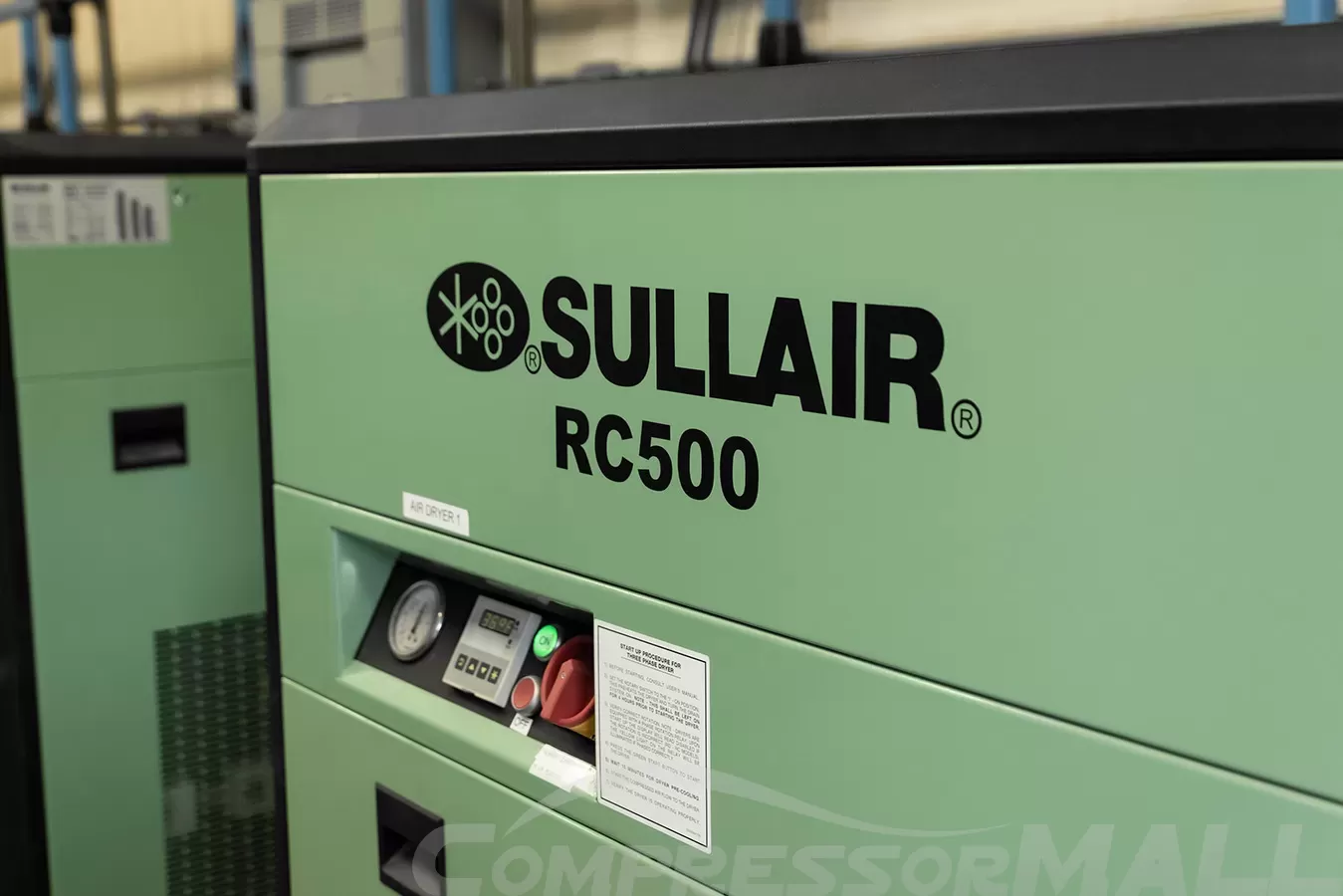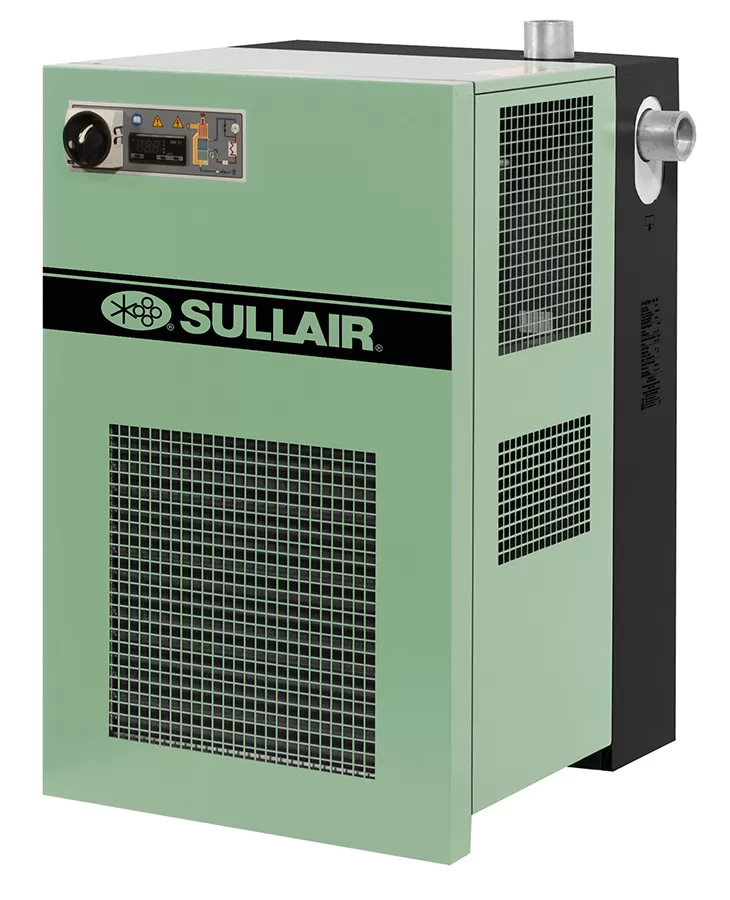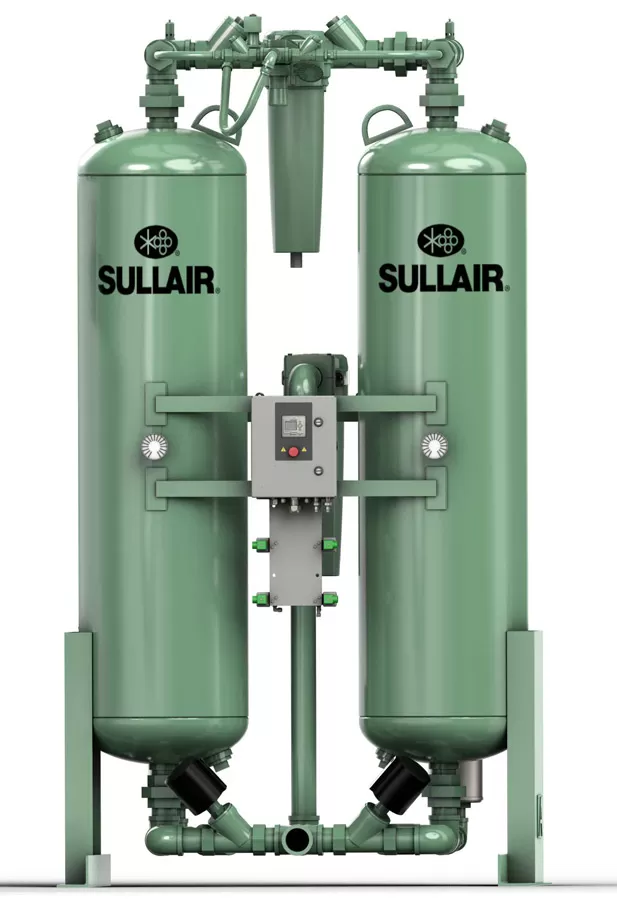All compressed air dryers have a maximum drying capacity expressed in cubic feet per minute (cfm). So to make sure your compressed air system has enough drying capacity, all you need to do is get a dryer with a rated cfm higher than your air compressor’s output cfm and that can handle the compressor’s output pressure, and you’re set, right?

Not quite. That cfm rating on your dryer represents SCFM, not ACFM, and ACFM is what you really care about.
SCFM? ACFM? What’s the difference? And why does it matter anyway?
What are SCFM and ACFM?
Standard cubic feet per minute (SCFM)
SCFM is the rated capacity of the dryer under standard conditions. While these can vary between countries and even manufacturers, the standard conditions used by Sullair (and in the United States generally) for dryers are:
- 100 psig inlet air pressure
- 100°F inlet air temperature
- 100°F ambient air temperature
- 100% saturated air (relative humidity)
Actual cubic feet per minute (ACFM)
ACFM is the maximum air flow the dryer can effectively dry after adjusting for actual operating conditions. Whenever your operating conditions don’t match the standard conditions, the ACFM of the dryer will not match the SCFM.
Why does it matter if I use ACFM or SCFM?
You always want to use ACFM. Why? ACFM adjusts for the environmental factors in your compressor room or other installation site that affect compressed air dryer performance.
SCFM doesn’t account for those factors. Unless your operating conditions exactly match standard conditions, you’ll be undersizing or oversizing your dryer if you use SCFM. (We’ll cover the problems with both of those later.)
So what environmental factors affect ACFM?

Inlet air pressure
Inlet air pressure and drying capacity are directly related. The higher the inlet air pressure, the higher the drying capacity, and vice versa.
Air moves more slowly as air pressure increases. Slower air movement means more contact time with either the heat exchanger (in a refrigerated air dryer) or the desiccant beads (in a desiccant dryer). The longer contact time increases dryer efficiency. Conversely, faster air means less contact time and decreases dryer efficiency.
Inlet air temperature
Inlet air temperature and drying capacity are inversely related. The higher the inlet air temperature, the lower the drying capacity, and vice versa.
Warmer air holds more water vapor than cooler air, so the dryer has to remove more moisture in the same amount of time, making it less efficient.
Ambient air temperature
Ambient air temperature and drying capacity are inversely related. The higher the inlet air temperature, the lower the drying capacity, and vice versa. but only for refrigerated dryers, at least directly.
As the ambient air temperature increases, the refrigerated dryer dissipates heat less efficiently, effectively reducing dryer capacity. Conversely, in cooler environments, dryer capacity is effectively increased because it can dissipate heat more efficiently.
Relative humidity
The vast majority of applications don’t have to adjust for relative humidity. Why not? Because under most ambient conditions, the air will be at 100% relative humidity once it reaches the dryer.
During compression, the air will typically reach 80 to 90% relative humidity at a high temperature (75°+ above ambient). After the air passes through the aftercooler, though, the temperature will drop to within 10 to 15° of ambient and become fully saturated at 100% relative humidity. (Remember, cooler air can hold less water vapor than warmer air.) Some moisture will even drop out as liquid water during the cooling process.
Should I oversize or undersize my dryers?

When sizing dryers, you want to be as close as you can to the size you need under worst-case conditions without going under. Why? Because the marginal costs of “sizing up” slightly, even for desiccant dryers, are relatively small compared to the ultimate potential costs of undersizing.
True, oversizing adds excess capacity and can increase capital, operating, and maintenance costs. For refrigerated dryers, it can also lead to shorter equipment life due to additional stress on the controls. But these costs can be planned for up front. And by keeping oversizing to a minimum, you can keep the cost to a minimum, too.
The effects of undersizing, however, cannot be planned for and minimized up front. Why? Because undersizing creates reduced drying capacity. The result? You won’t meet the level of dryness (the pressure dew point) your process, application, or equipment needs. This could lead to equipment damage or failure. In some cases, it could even lead to an unusable end product, with botched work products (for example, a ruined paint job) or entire production runs wasted.
A note on compressors and filters
Air compressors can also be affected by actual conditions that can change their output flow and pressure. In addition, filters between the compressor and dryer can create pressure drop.
When using correction factors (see the next section), make sure you use the output pressure of the compressor after adjustments for actual conditions as well as drops caused by filters.
How do I calculate a dryer’s ACFM?
Compressed air dryers have correction factors to take into account actual conditions so dryers can be sized correctly. (The correction factors are usually given in the dryer literature). If your conditions can vary, use the correction factors for the worst set of conditions your system will face.
The formulas used for calculating ACFM are:
- Refrigerated dryers: ACFM = SCFM × inlet pressure correction factor × inlet temperature correction factor × ambient temperature correction factor
- Desiccant dryers: ACFM = SCFM × inlet pressure correction factor × inlet temperature correction factor
Once you have the dryer’s ACFM for your worst-case scenario, compare that to the inlet cubic feet per minute (ICFM) coming into the dryer. If the dryer’s ACFM is higher than the ICFM, the dryer has enough capacity to meet your needs.
Examples
You need to dry 458 ICFM. After filtration, under worst-case conditions the inlet pressure will be 140 psig, the inlet temperature will be 110°F, the ambient temperature will be 105°F, and the relative humidity will be 80%.
Refrigerated dryer
Would a Sullair SR+ 500 meet your needs?
Applying the correction factors for a SR+ 500 to the formula given above for refrigerated dryers, we get:
- ACFM = 500 (rated SCFM) × 1.13 (the correction factor for 140 psig inlet pressure) × 0.82 (the correction factor for 110°F inlet air temperature) × 0.94 (the correction factor for 105°F ambient air temperature)
- ACFM = 500 × 1.13 × .82 × .94
- ACFM = 435
435 ACFM is smaller than 458 ICFM, so the SR+ 500 will not have enough capacity for your application.
Desiccant dryer
Would a Sullair SA‑500 meet your needs?
Applying the correction factors for a SA‑500 to the formula given above for desiccant dryers, we get:
- ACFM = 500 (rated SCFM) × 1.29 (the correction factor for 140 psig inlet pressure) × 0.76 (the correction factor for 110°F inlet air temperature)
- ACFM = 500 × 1.29 × .76
- ACFM = 490
490 ACFM is larger than 458 ICFM, so the SA‑500 will have enough capacity for your application.


